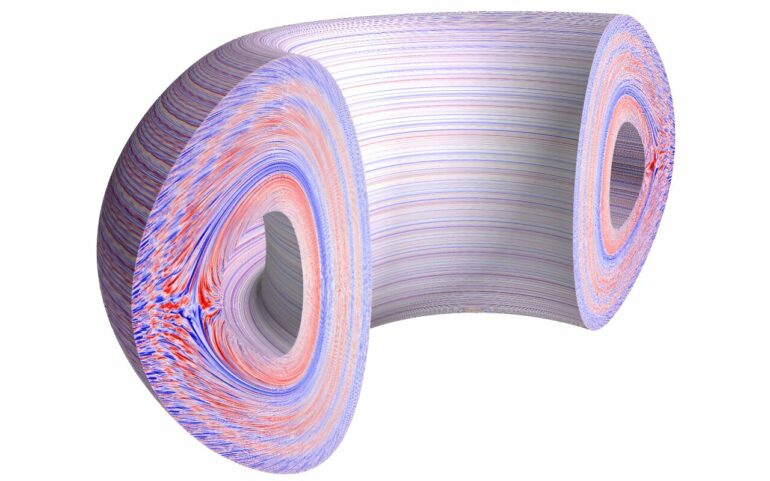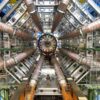Nuclear fusion—when two nuclei combine to form a new nucleus, thereby releasing energy—may be the clean, reliable, limitless power source of the future. But first, scientists must learn how to control its production.
Building on decades of prior research, scientists have developed sophisticated techniques to improve the confinement of superhot plasma within tokamak fusion reactors. Tokamaks are systems that employ massive magnetic coils around a donut-shaped chamber to control charged plasma particles formed from hydrogen fuel.
Confinement in tokamaks is limited by the small but steady heat loss caused by turbulence—the same effect that leads to unsteady flight in planes or the complicated swirls of cream in your coffee.
One important method to improve tokamak confinement is a byproduct of the commonly used neutral beam injection, or NBI, system. NBI uses an intense particle beam to heat the plasma to 150 million degrees Celsius—10 times hotter than the core of the sun—for fusion to occur. In addition to heating the plasma, this beam also causes the plasma to rotate around the tokamak’s chamber. This rotation was universally believed to improve the quality of confinement.
However, a new study conducted on the Frontier supercomputer at the Department of Energy’s Oak Ridge National Laboratory revealed important exceptions to this rule.
In a paper published in Plasma Physics and Controlled Fusion, researchers from General Atomics and the University of California San Diego revealed surprising results from a precise exascale simulation of turbulence in the plasma edge, close to the tokamak’s outer walls.
“The plasma edge region is really important because it sets the global confinement of energy and heat in the plasma. But calculating the turbulence in this edge region is very difficult. To do this, you must capture the subtle interaction between very heavy ions and very light electrons—an interaction that is frequently ignored,” said Emily Belli, a physicist at General Atomics in San Diego and lead author of the paper.
“When scientists did previous simulations in this edge region, they were limited computationally and could only have the ion physics or only have the electron physics. They couldn’t describe the complex interplay between the two. This became possible for us with Frontier.”
With team members Jeff Candy of General Atomics and Igor Sfiligoi of UC San Diego, Belli carefully studied this ion-electron interaction in the edge region. Using General Atomics’ open-source CGYRO gyrokinetic code, along with data from DOE’s DIII-D National Fusion Facility, the team modeled the effect of plasma rotation on both ions and electrons.
Previous studies had indicated that rotation would reduce the turbulence caused by ions. It was also theorized that the rotation would not affect the electrons because they are so light and fast. This study’s results contradict that theory.
“We found that when you include the interaction between the ions and the electrons, the rotation can increase the overall level of turbulence, which subsequently reduces the quality of confinement,” Belli said. “While the ions’ turbulence is favorably reduced, the total turbulence can actually increase, and that’s unfavorable for a reactor.”
The team’s findings could help to optimize the design of future tokamaks, including ITER, the international collaboration in France to build the world’s largest tokamak. “We might consider different ways to heat the plasma or different scenarios to operate the tokamak to keep us away from operating regimes where confinement is degraded by this new mechanism,” Belli said.
The team also studied the effects of using different isotopes in the hydrogen plasma fuel. Specifically, they simulated operation with an even split of deuterium and tritium mix, or DT, which will produce the maximum fusion reaction rate. ITER plans to use this DT mix once its reactor is commissioned, targeted for 2025.
Tritium is not common and is difficult to work with because it is radioactive, making experiments rare. But in February, the United Kingdom Atomic Energy Authority’s Joint European Torus, or JET, tokamak produced a record-breaking 69 megajoules of sustained fusion energy for 5 seconds using DT. The fact that JET achieved this milestone using DT fuel demonstrates that this approach is feasible and provides valuable data for ITER and future fusion experiments.
The General Atomics team’s performance prediction for DT matched the JET experiment’s results, validating CGYRO’s ability to capture the correct physics in the fusion process.
“We were able to find that, in this regime, the DT plasmas will have better confinement than the deuterium plasmas. That’s an important result going forward because it predicts that when ITER does use this 50-50 DT, the performance will be better than what we are getting in the deuterium experiments,” Belli said.
CGYRO saw a fivefold performance increase going from the petascale—a quadrillion or more calculations per second—Summit supercomputer to the exascale —a quintillion or more calculations per second—Frontier supercomputer, both managed by the Oak Ridge Leadership Computing Facility, a DOE Office of Science user facility located at ORNL.
This increase in computational power enabled Belli’s team to increase the simulation’s grid resolution and accurately capture the interactions between the hydrogenic fuel ions and electrons.
“Fusion is a nonlinear process, with many tightly coupled physics components. We need a supercomputer to keep track of the subtle interactions between components that have a real impact on the fusion performance,” Belli said. “All the effects that we accounted for in our simulation were not always in agreement with the simpler theories that you get from analyzing the various components in isolation.”
Belli and her team are continuing their INCITE research project on Frontier, now studying the effect of impurities on plasma performance in fusion reactors.
“The tokamak wall is made from metal, and particles from it can come into the plasma, potentially diluting it or causing unwanted radiation, and decreasing its performance. But with the power of Frontier, we’ll be able to capture these multiple-ion effects,” Belli said.
More information:
E A Belli et al, Flow-shear destabilization of multiscale electron turbulence, Plasma Physics and Controlled Fusion (2024). DOI: 10.1088/1361-6587/ad2c28
Provided by
Oak Ridge National Laboratory
Citation:
Using supercomputer researchers discover new clues to improving fusion confinement (2024, June 25)



